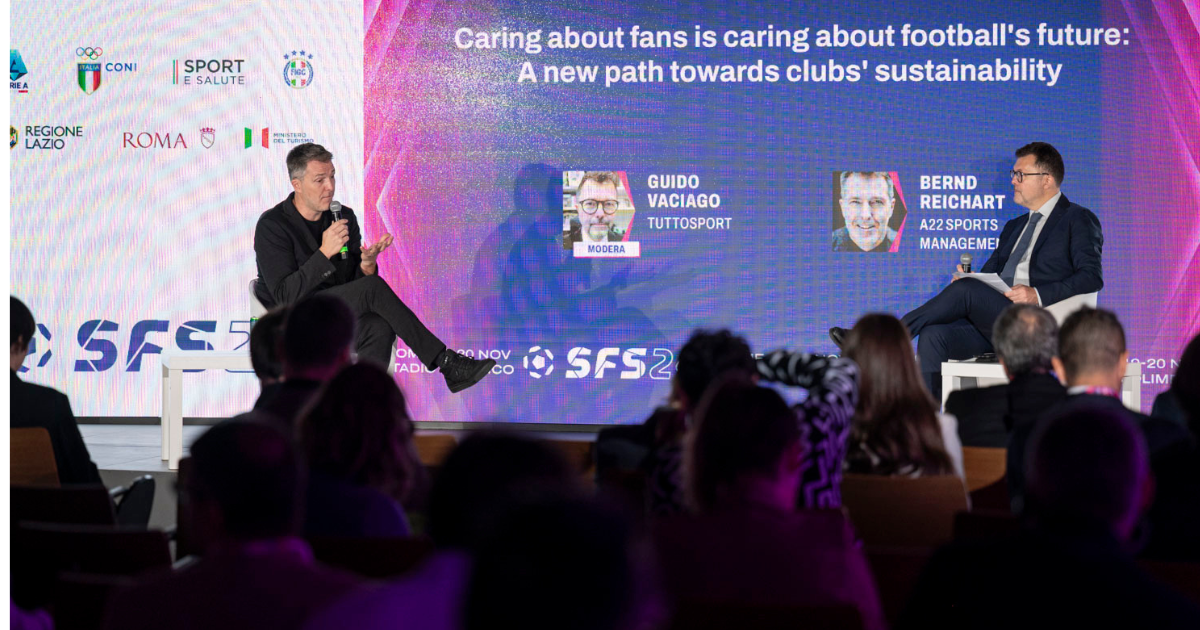
SFS24: SUPERLEAGUE, SUSTAINABILITY, AND THE FUTURE OF FOOTBALL
The debate around the Superleague has never truly faded. Over the past three years, football has been at the center of a clash between opposing visions: on one side, the “football of the people”, and on the other, the “football of the rich”. But is it really so easy to draw a line between good and bad? Probably not, and this is one of the reasons why the future of football remains a divisive topic, with generations confronting each other on different ideas to innovate a sport that today seems to struggle to fully engage its fans.
During SFS24, discussions focused on how to make football more sustainable and appealing to new generations. On stage were Bernd Reichart, CEO of A22 (the company promoting the Superleague project), and Guido Vaciago, Director of Tuttosport, who analyzed current issues and possible solutions.
Clubs need to be closer to fans’ interests: this was one of the central points raised during the discussion. Today, competitions are not perceived as exciting as they should be. The current system seems to alienate fans, making access to football increasingly unequal. Added to this is the problem of high costs, which drive many enthusiasts towards alternative solutions, such as piracy.
Bernd Reichart stated: “Economically, fewer fans are paying more. This model is unsustainable. The solution is to offer advantageous, accessible platforms at reduced prices, capable of meeting fans’ needs”.
Another crucial element is the need to improve the fan experience. According to Reichart, creating a dedicated platform could not only increase engagement but also introduce a framework of content beyond the matches themselves. In this context, big tech companies could play a key role, as already seen in the NBA and NFL, where proprietary platforms allow leagues to build direct connections with their fans.
This approach could also be extended to women’s football, which currently suffers from limited visibility. “The time to act is now”, Reichart emphasized, highlighting that models based on advertising, subscriptions, and a direct-to-consumer (D2C) strategy represent an interesting path forward.
During the panel, criticisms of the current format were also voiced. The new Champions League does not seem to convince fans and industry insiders, who lament a loss of competitiveness and appeal. “A disconnection has been created between clubs and the competition, and fans are nostalgic for the old formats”, said the CEO of A22.
Scheduling was another central theme. The excessive density of fixtures risks compromising the quality of football as a product. According to A22, a balanced calendar should result from a more transparent process, involving players and granting clubs greater decision-making autonomy. This is one of the cornerstones of the Superleague format, which aims to offer more transparency and greater prominence to participants.
With the CGUE ruling questioning the monopoly of traditional football organizations and the “Unify League” proposal presented in December 2024, new scenarios are opening up for European football. However, the question remains: which direction is best to ensure a sustainable, engaging, and accessible future for football?
The next moves by both traditional institutions and innovative entities like A22 will be crucial in shaping the future of a sport that continues to be at the heart of the passions of millions around the world.



